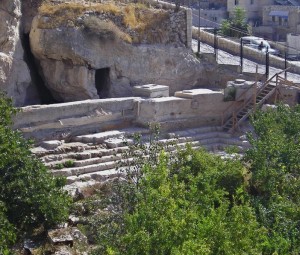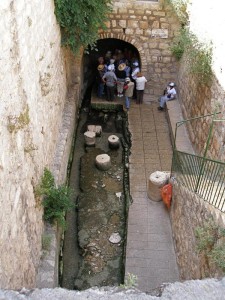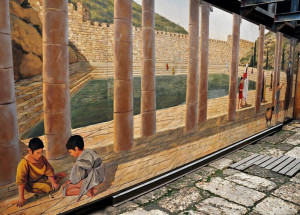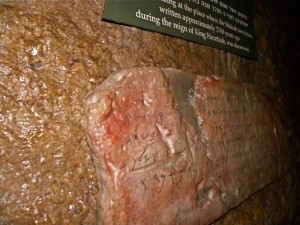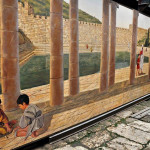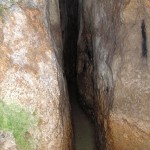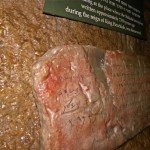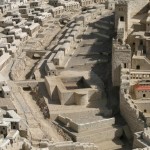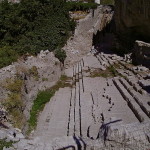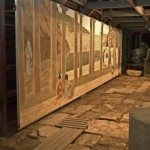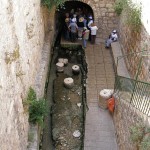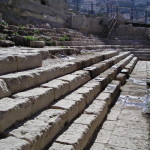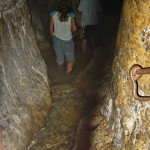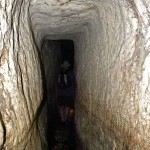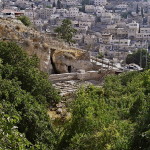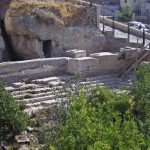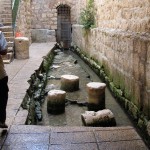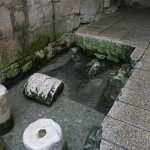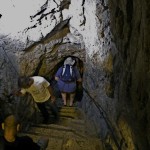Jerusalem
The Pool of Siloam, where Jesus ordered a blind man to go to wash mud out of his eyes, lay undiscovered until 2004.
Then a drainage repair crew, working on pipe maintenance south of the Old City of Jerusalem, uncovered large stone steps that had led to an ancient pool dating from the first century BC.
Until then, a much smaller pool 50 metres north-west, at the end of Hezekiah’s Tunnel, had been regarded as the Pool of Siloam.
The account of the healing of the man who had been blind since birth (John 9:1-41) is one of the longest Gospel narratives of any of the miracles of Jesus.
The disciples asked whose sin had caused the man’s blindness, his own or his parents? Neither, said Jesus; he was born blind “so that God’s works might be revealed in him”.
Then Jesus spat on the ground, made mud with his saliva and spread the mud on the man’s eyes. “Go, wash in the Pool of Siloam,” he said. The man did as he was told, and he was able to see.
Smaller pool had ‘hanging basilica’
The pool rediscovered in 2004 had been destroyed by the Roman conquerors around AD 70 and gradually covered by debris.
In the 5th century the smaller pool, further up the southern slope of the City of David, was remodelled, apparently by the Byzantine Empress Eudocia. A church named “Our Saviour, the Illuminator” was built over the pool.
A 6th-century pilgrim described a “hanging basilica” over the pool, in which men and women washed separately in two marble basins “to gain a blessing”.
The church was destroyed in 614 and never rebuilt. The pool was also abandoned. Bounded by high stone walls, it contains some scattered fragments of column drums from the church.
This narrow, rectangular pool has long been visited as the site of Jesus’ miracle. It is also the place where walkers through Hezekiah’s Tunnel emerge.
Monumental steps led to pool Jesus knew
The rediscovered pool, which archaeologists began to excavate in 2004, was also fed by water from Hezekiah’s Tunnel, through a channel leading from the smaller pool.
Coins found in the cement show it was in use in Jesus’ time, when four sets of monumental steps led from street level into the pool.
One side of the pool had been buried under a lush garden with figs, pomegranates, cabbages and other fruits.
This property, once part of an orchard known as the King’s Garden, belonged to the Greek Orthodox Church. The building of a wall around the pool and the garden is recorded in Nehemiah 3:15.
In December 2022 Israel authorities announced plans to fully excavate the site and include the pool in a controversial “Pilgrims Route” from the City of David to the Western Wall.
Hezekiah’s workmen were ingenious
Hezekiah’s Tunnel was cut through solid rock at the beginning of the 8th century BC. One of the most ingenious engineering accomplishments of ancient times, it bears testimony to the crucial importance of a water supply to Jerusalem.
In times of war and siege, the City of David was vulnerable, since it depended on water from the Spring of Gihon. This spring, which gushes forth intermittently from a natural cave in the Kidron Valley, was outside the city walls.
King Hezekiah decided to bring water from the spring into the city. Following part of a natural fissure, two sets of teams began at opposite ends to cut a winding 533-metre tunnel on a double-S course — and they met in the middle.
Axe and chisel marks can be seen along the entire length of the tunnel, which averages 60 centimetres wide and 2 metres high.
Inscription describes breakthrough
In 1880 a boy discovered an inscription in the rock near the mouth of the tunnel, which records its construction.
Of the final breakthrough, it says: “While the labourers were still working with their picks, each toward the other, and while there were still three cubits to be broken through, the voice of each was heard calling to the other, because there was a [crack?] in the rock to the south and to the north. At the moment of breakthrough, the labourers struck each toward the other, pick against pick. Then the water flowed….”
Hezekiah’s Tunnel may be traversed on foot, best starting from the Spring of Gihon, outside the Dung Gate. A reliable torch is necessary and footwear is advisable. Water is generally knee-high but can rise to waist height.
In Scripture:
King Hezekiah digs a tunnel: Sirach 48:17
Building the Pool of Siloam: Nehemiah 3:15
Jesus heals a blind man: John 9:1-41
- Mural showing what Pool of Siloam might have looked like (© Ferrell Jenkins)
- Outlet of Hezekiah’s tunnel into the upper pool at Siloam (Seetheholyland.net)
- Reconstruction of 8th-century inscription by workers digging Hezekiah’s Tunnel (Ian W. Scott)
- Pool of Siloam in the Model of Ancient Jerusalem at Israel Museum (© Tom Callinan / Seetheholyland.net)
- Looking down on the steps which led to the pool, at left (Abraham / Wikimedia)
- Reconstructed ancient street at Siloam (© Israel Ministry of Tourism)
- Upper pool from above with outlet of Hezekiah’s Tunnel at far end (Seetheholyland.net)
- Close-up of steps leading down to the pool, which probably originally ran around all four sides (Abraham / Wikimedia)
- Inside Hezekiah’s Tunnel (David Q. Hall)
- Narrow width of Hezekiah’s Tunnel (Ian W. Scott)
- Looking east over the site of the Pool of Siloam towards the neighbourhood of Silwan (Abraham / Wikimedia)
- Steps leading down to the Pool of Siloam (Abraham / Wikimedia)
- Upper pool at the outlet of Hezekiah’s Tunnel (Seetheholyland.net)
- Column drums from Byzantine basilica in the upper pool (© Tom Callinan/Seetheholyland.net)
- Descent into Hezekiah’s Tunnel at the Gihon Spring (Ian W. Scott)
References
Gonen, Rivka: Biblical Holy Places: An illustrated guide (Collier Macmillan, 1987)
Mackowski, Richard M.: Jerusalem: City of Jesus (William B. Eerdmans, 1980)
Maugh, Thomas H. II: “Biblical Pool Uncovered in Jerusalem”, Los Angeles Times, August 9, 2005
Murphy-O’Connor, Jerome: The Holy Land: An Oxford Archaeological Guide from Earliest Times to 1700 (Oxford University Press, 2005)
Obel, Ash: “Israel, right-wing group to fully excavate biblical Siloam Pool in East Jerusalem”, The Times of Israel, December 27, 2022
Wareham, Norman, and Gill, Jill: Every Pilgrim’s Guide to the Holy Land (Canterbury Press, 1996)
External links

